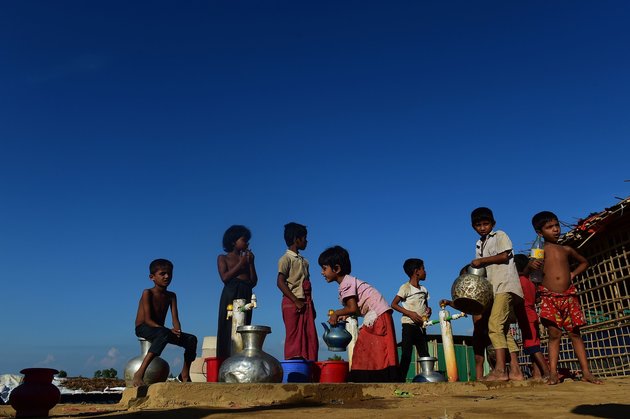Myanmar’s Myriad Challenges Don’t Excuse Toxic and Unfounded Racism against Rohingya
ASIA--PACIFIC, 27 Nov 2017
Khin Mai Aung | HuffPost – TRANSCEND Media Service
The prevailing perception of the Rohingya as foreign and fundamentally not “Burmese” is misplaced.
20 Nov 2017 – The Rohingya humanitarian crisis has shone a bright and unflattering light on the deep and ugly antipathy within Myanmar (also referred to as Burma) to the Rohingya people. While most western media have focused single mindedly on the Myanmar military’s horrific persecution of the minority group, some have warned that the present situation in Myanmar is immeasurably complex, implying that armchair observers shouldn’t rush to judgment.
I take a hybrid view. As I acknowledged in my recent article, conditions in Myanmar are indeed difficult and daunting, to no fault of the Burmese citizenry. They’ve endured colonialism, followed by decades of military rule in which a culture of xenophobic isolationism took root. Now, the country is going through democratization and modernization at breakneck speed. But these challenges and struggles don’t excuse or mitigate the hate brewing inside Myanmar, or the weak premises underlying the contention that the Rohingya are a fundamental threat to the country. It’s critical to call out Burmese extremists’ fears and prejudices for as unfounded, and to counter them with sober responses based on fact and reason. The Burmese diaspora and its friends are uniquely positioned to play a role in this process. While not everyone may wish to or be able to speak out publicly, we can all engage loved ones in Myanmar and abroad to push back on, educate about, and question any misconceptions and biases they harbor. Doing so may be a critical opportunity to help stem the dangerous tide of extremism engulfing Myanmar.
Many Burmese feel an urgent and visceral fear of the Rohingya, based on the perception that the very survival of Myanmar and its Buddhist identity are at risk from perceived Rohingya population expansion due to immigration from Bangladesh and a high birth rate. This fear is unfounded. While a precise count is difficult because most Rohingya are not included in the country’s national census, official data indicates that Muslims constitute about 2.3% of Myanmar’s population. Unofficial counts including the Rohingya estimate Myanmar’s total Muslim population at about 4%. By contrast, the vast majority (almost 90% in official numbers) of Myanmar’s population is Buddhist. With this in mind, even with some margin of error, neither the Rohingya nor other Muslims, nor even all religious minorities combined, threaten the dominance of Buddhism in Myanmar. The real threat to Burmese Buddhism is from within, from religious extremists who subvert our religion’s nonviolent underpinnings and seek to transform it into a force of hate and intolerance.
The prevailing perception of the Rohingya as foreign, and fundamentally not “Burmese” is also misplaced. Many Burmese believe the term “Rohingya” is artificial and newly constructed in modern times, instead referring to them as “Bengali.” It’s true that many Muslims from Myanmar’s Rakhine state actively coalesced around the Rohingya identity in modern times, in response to the crystallization of a strain of Burmese nationalism centered on Buddhism, which by definition excluded them. But this doesn’t change the fact that Rohingya have lived in Rakhine state for centuries, even if newer migrants entered Myanmar more recently. And while the Rohingya language is closely related to Chittagonian Bengali, the Rakhine language is also very similar to Bamar. Yet, few in Myanmar would deny that the Rakhine are a distinct ethnic group separate and apart from the majority Bamar population, linguistic similarities aside.
Fear of terrorism plays a role, as this year’s military crackdown on the Rohingya was instigated by a violent attack by the terrorist Arakanese Rohingya Salvation Army (ARSA). However, while the broader threat of terrorism is a valid concern, it’s quite possible that Myanmar’s hardline response will only motivate more Rohingya to join ARSA and potentially put the country more prominently on the map of global terrorist networks.
Another part of the equation is racism. Burmese often use the derogatory term “kala” to refer to individuals of South Asian descent, regardless of their religion. But even within this population, the Rohingya are especially identified as perpetual foreigners, and their lack of belonging is aggressively emphasized. Beyond the pale, the Rohingya are profoundly and shockingly dehumanized in Myanmar, and compared to parasites and vermin. In a recent speech to soldiers at a military base, a prominent Burmese monk implied that it is permissible to kill non-Buddhists like the Rohingya because they are less than human. This is shocking, and a directly contradicts Buddhism’s central principle of non-violence and doing no harm to other living creatures.
The Burmese military has ruled the country unchecked for decades, and the Buddhist nationalism surging in Myanmar today is part of a ruthless military strategy for social and political control. Throughout its reign, the military has promoted Burmese nationalism focused on Buddhism, in contrast to comparatively more inclusive nation building in the immediate post-colonial era. During the recent transition to democracy, the military fomented anti-Muslim sentiment to boost support, portraying Aung San Suu Kyi’s National League for Democracy (NLD) as too accommodating to the Rohingya. The NLD shouldn’t be let off the hook for failing to produce a more tolerant counter narrative, but it’s critical to remember that the hate roiled by Myanmar’s Buddhist nationalists didn’t erupt organically. Buddhist extremism has long been a component of the military’s long-term strategy for consolidating support and securing the Myanmar state.
As a Burmese American of Rakhine and Bamar descent, I fear that many good people in my country of birth and religion have lost their way, succumbing to fear and hate stirred by same brutal military that held Myanmar under its thumb for decades. Many Burmese Buddhists have forgotten the principles behind the country’s hard-won road to democracy, aligning with the very oppressors that the Myanmar resistance struggled against for years. The Rohingya, many of whom supported the NLD prior to the country’s transition to democracy, are not the enemy of Burmese Buddhists who desire a peaceful democratic state, but their allies and countrymen. The sooner that Myanmar’s citizenry is able to recognize this critical fact and move beyond the hysteria and prejudices gripping much of the country’s population, the sooner it can identify and fight its real enemies – Buddhist extremists who preach hate and violence, and the ruthless military which enables and eggs them on.
_________________________________________________
 Khin Mai Aung has written about civil rights issues in publications such as The New York Times, San Francisco Chronicle, and Salon in addition to the Huffington Post, and was formerly a lawyer at the Asian American Legal Defense and Education Fund.
Khin Mai Aung has written about civil rights issues in publications such as The New York Times, San Francisco Chronicle, and Salon in addition to the Huffington Post, and was formerly a lawyer at the Asian American Legal Defense and Education Fund.
DISCLAIMER: The statements, views and opinions expressed in pieces republished here are solely those of the authors and do not necessarily represent those of TMS. In accordance with title 17 U.S.C. section 107, this material is distributed without profit to those who have expressed a prior interest in receiving the included information for research and educational purposes. TMS has no affiliation whatsoever with the originator of this article nor is TMS endorsed or sponsored by the originator. “GO TO ORIGINAL” links are provided as a convenience to our readers and allow for verification of authenticity. However, as originating pages are often updated by their originating host sites, the versions posted may not match the versions our readers view when clicking the “GO TO ORIGINAL” links. This site contains copyrighted material the use of which has not always been specifically authorized by the copyright owner. We are making such material available in our efforts to advance understanding of environmental, political, human rights, economic, democracy, scientific, and social justice issues, etc. We believe this constitutes a ‘fair use’ of any such copyrighted material as provided for in section 107 of the US Copyright Law. In accordance with Title 17 U.S.C. Section 107, the material on this site is distributed without profit to those who have expressed a prior interest in receiving the included information for research and educational purposes. For more information go to: http://www.law.cornell.edu/uscode/17/107.shtml. If you wish to use copyrighted material from this site for purposes of your own that go beyond ‘fair use’, you must obtain permission from the copyright owner.
